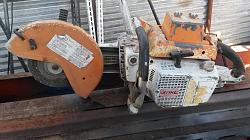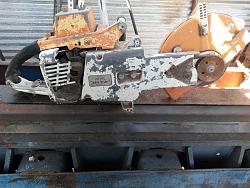not to worry,, i was just adding what little bit i felt comfortablw with observing,, buckBuck I did not mean to imply that the hull was a forging what I said was there are forgings utilized in the making of tanks. and yes the panzer could have been a welded assembly of welded parts then as you said heated to normalize and harden. The process of doing something like that bringing it to a full red color would be extremely stressing on any welded areas as rolled plate steel has a natural directional grain which cause it to expand in differing directions when heated. One reason for my belief that this is a steel casting is the lack of any fixtures jigs or braces to be seen which would be very prevalent if this were a weldement as such items are never removed prior to heat treating. otherwise the whole assembly could become misshapen to the extent of being scrap metal.
Whereas a homogeneous casting is grain neutral even when poured by multiple crucibles as long as the plug remained at temperature.
I was once hired or rather asked do do a favor by the owner of a company that had a contract fabricating transport fixtures for the engines that were used on one of the fighter jets For Lockheed Martian, see if I might have or be able to come up with a solution for their problem. They were experiencing a near 100% NO-GO rating on their fixtures after they returned from heat treatment. the Gov inspector would sign off on the fixture prior to heat treating for fit finish and tolerances . Upon their return he failed every one of them. some measurements would be undersized some over sized some out of dimensional squareness , parallel, angles were off, you name it if there was a possibility to be wrong they would be. then they started sending them in still in fixtures this made an improvement but still not within specs. I started noting the dependencies then I noticed a pattern of the under and over out of square and so forth so once I thought I had most of it figured out I instructed the companies engineers to spec out some new fixtures with built in adjustments plus add in some fixtures in several different places most of those could not be put in place until the weldement was completed.
After the G man signed off on the assembly to sent it out for treatment we tweaked the jigs here and there by just a little more than the final discrepancies were and added in the extra fixtures. then sent the one frame out to be treated when it returned we removed all of the fixtures prior to final inspection as was SOP
the frame received an 80% pass which was close enough for the G man to say that it could be ground and reamed and utilized.
After that first passing grade all of their frames passed even closer to specs by the end of their contract I heard they were obtaining a near perfect pass rating
I got a brand new 1984 Hobart Meg a arc 400 amp diesel welding machine for my troubles out of the deal



 LinkBack URL
LinkBack URL About LinkBacks
About LinkBacks



 Reply With Quote
Reply With Quote






Bookmarks